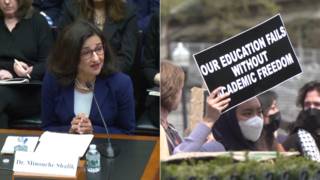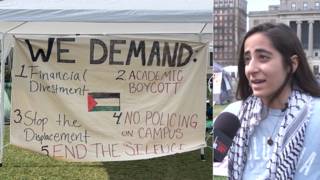
Related
Guests
- Bobby Sealethe original 1966 founding chairman and national organizer of the Black Panther Party.
As we revisit the 1968 Democratic National Convention in Chicago that became a national spectacle 50 years ago when police attacked demonstrators, we are joined by Bobby Seale, who was chair of the Black Panther Party when he spoke at the demonstrations and was later arrested and became part of the Chicago 8. Seale describes how at his conspiracy trial the judge ordered that he be gagged and bound to his chair. He was sentenced to 48 months in prison for 16 acts of contempt of court, but all of the charges were later dismissed.
More from this Interview
- Part 1: 50 Years Ago: Antiwar Protesters Brutally Attacked in Police Riots at 1968 Democratic Convention
- Part 2: Bound & Gagged: Black Panther Party Chair Bobby Seale Describes His Trial After 1968 DNC Protests
- Part 3: 1968 DNC Protests, 50 Years Later: Organizers Recall Coalition Building & Running Pig for President
- Part 4: Bobby Seale, Bill Ayers & Bernardine Dohrn on Police Repression, Fred Hampton Murder & Prison Strike
Transcript
AMY GOODMAN: And now we’re going to turn to a clip of Bobby Seale speaking in Chicago in 1968 outside the Democratic convention during the protests.
BOBBY SEALE: We go forth as human beings to remove these pigs, these hogs in the power structure, murdering and brutalizing people not only here in the confines of racist, decadent America, but murdering, brutalizing and oppressing people around the world. And when we go forth to deal with them, the devil always send out their racist, dirty, rotten pigs to occupy the people, to occupy the community, such as the way they have this park here occupied. Now, just a second. There’s a lesson that Minister of Defense Huey P. Newton teaches, that whenever the people disagree with the political decisions that have been made upon their heads, that whenever the people disagree with those political decisions, the racist power structure sends in guns and force to see that the people accept those political decisions. But we are here as revolutionaries to let them know that we refuse to accept those political decisions that maintain the oppression of our black people and other people in the world.
JUAN GONZÁLEZ: That was Bobby Seale, the founding chairman of the Black Panther Party, speaking at one of the demonstrations in the early days of the Chicago Democratic National Convention protest. And I want to welcome Bobby Seale to the program. Bobby, one of the parts of the history of the Chicago demonstrations that’s left out is that it wasn’t just young white people. Obviously, the Black Panther Party was involved. The Young Lords of Chicago were involved, as well, in the protests. Could you talk about how the various groups managed to come together outside the Democratic National Convention that year?
BOBBY SEALE: We were all about coalition politics anyway. This is one of the factors that I injected into my organization relative to Dr. Martin Luther King, Dr. Reverend Ralph Abernathy calling me, before Dr. King was killed, to help join with him and them to do the Poor People’s March for greater economic rights. Coalition politics was a main character of where we were coming from. So, the Young Lords, etc., and others, I mean, the real Rainbow Coalition started with the Black Panther Party and the Young Lords and the Young Patriots. Young Patriots were young white students out of the Appalachian Mountains in the mining companies, etc. And we were all coalesced, all the ethnic groups, etc. And that’s where we were coming from.
But when I spoke at Lincoln Park, one of the things I stated there—because I had seen on television before I arrived there that it was a police riot. And I was telling them that power of the people is the ability to define phenomena, then, in turn, make it act in a desired manner. So the phenomena of the racist police coming upon you peaceful protesters, unarmed, etc., and beating on you, you’re going to have to try to struggle and move around and try to see if you can grab that billy club out of one of them’s hand and beat them back, therefore making them act in a desired manner. My point was, that, itself, when I made that statement, they had pulled me back to the Chicago trial a year later, and the DA tried to say, “You meant kill the police, right, Bobby?” I says, “No, I meant defending ourselves, you know.”
But my point is, the whole mess of even charging us, me and others, with interstate transportation, you know, was based on the Rap Brown law—you know what I mean?—that had been pigeonholed. But after Dr. King was killed, so many riots happened, the Congress pulled it out and made it a law you can’t use interstate transportation or use interstate highways to cross state lines with the intent to incite a riot. I spoke at Lincoln Park. Next day I spoke at Grant Park across the street from the Conrad Hilton Hotel. Half the people of the 400 or 500 people there, maybe half of those people, were all in suits, like they were delegates, you know, to the convention. Nobody rioted, you know what I mean. And then, of course, I left and went back to—went back to Oakland, California, organizing chapters and branches around the country of my organization.
AMY GOODMAN: I want to read from a December 1968 copy of Life magazine on the police violence during Chicago in the protests against the DNC. The cover of the issue reads, quote, “Walker Report Discloses the Police Rioted at the Democratic Convention.” An article in the issue quotes a police transmission that captured what police officers said on their radios: quote, “We’ve got an injured hippie.” “That’s no emergency.” “Kick the f—er.” “Knock his teeth out.” Just an example of what was going on then. Now, Bobby, you didn’t get arrested there at the convention, right? You were there for the first two days. In fact, you were a last-minute stand-in for Eldridge Cleaver, is that right? Why did you come to Chicago?
BOBBY SEALE: Yeah, well, that was the reason. Eldridge Cleaver’s parole officer would not let him leave the state of California, so Eldridge called me up at Ramparts magazine, where I worked at the time, and asked me to take his place. So I called all my people, etc., to get some airline tickets, what have you, etc., and we flew to Chicago, because I went there with an entourage, you know what I mean, etc. In fact, we were armed. You know, those are the days we could still—we could still carry guns on the plane, you know what I mean? And a lot of the times we moved around very armed, because we had over three-and-a-half thousand threatening letters over the years, that I had given to our lawyers to make sure, because you never could tell when they were going to attack us and stuff like this here.
But I’m just saying, when I was arrested, I was arrested for New Haven, Connecticut, the other trial. I was out on bail for the Chicago trial, and they arrested me at another point. And when the trial came, I’m in jail the whole period of the trial that I was there, the seven months that I was protesting in the courtroom. And the other seven defendants are not in jail, because they are—you know, they didn’t have a capital charge like I had—you see?—in New Haven, Connecticut.
JUAN GONZÁLEZ: I also—
AMY GOODMAN: I just want to go back to that, because you’ve mentioned the trial—I mean, this was an enormous deal—especially for young people who aren’t aware of what took place in 1970. Again, you were arrested months after the protests and charged with conspiring to riot, Bobby. And you were part of the Chicago 8. Explain what—
BOBBY SEALE: No, I was never—
AMY GOODMAN: And then you were severed from the case.
BOBBY SEALE: I was severed from the case, but I was in jail for another charge. I was never in jail for Chicago, the charges of Chicago. I never had to go to jail. I posted bail when they first charged me. I was never arrested in jail.
I returned from Scandinavia. I returned from Scandinavia. I was 12 days in Scandinavia—Norway, Sweden, Finland, what have you, etc.—speaking and lecturing. And while I was there, the indictment against me came down. I was very shocked when I hit Finland, because people kept telling me—and there was probably underground CIA agents in all these places I spoke—says, “Are you going to go to Helsinki, Finland?” I says, “Yeah.” “Well, you know, when you get to Helsinki, Finland, you’re only 125 miles from Leningrad. Boom.” I says, “Lady, I ain’t interested in no Leningrad,” because I wasn’t. I didn’t like the USSR at all, because even when I got there, they interviewed me at some press conference at some parliament place, and I did not care for the state-control, command-economy socialism concepts related to it, and I like democratic socialism concepts rather than that. But I’m just saying—
AMY GOODMAN: But when you were actually in the trial, when you were in the courtroom, explain what happened.
BOBBY SEALE: Yes.
AMY GOODMAN: Explain what Judge Hoffman did in having you bound to a chair and gagged.
BOBBY SEALE: Well, he charged—bound after seven—six weeks of protesting in the courtroom. What I was protesting was, is that I had put a motion in before the trial started, in jail. In other words, I got the right to call my lawyer, Charles Garry, who was in the hospital. The judge was trying to push Kunstler on me. But when I got my lawyers to dictate to me over the phone, I wrote out the motion, with carbon copies. And then, when they brought me into court, before the trial actually started, I asked to step to the lectern to read a motion—and I did—for the right to defend myself, etc., and so on, etc. And the judge denied it. And then we get in an argument. “The Sixth Amendment of the Constitution of the United States of America say I have legal right to my choice of my lawyer, and you cannot push Kunstler on me.” So that became part of my strategy against the very trial, while at the same time, remember, I’m charged with conspiracy to commit murder, which is a trumped-up FBI operation, in Connecticut, that I have to later face after I finish the Chicago trial. That’s the reason I’m in jail. I’m not in jail because of Chicago, I’m just saying.
So I argued in the courtroom every time. Every time my name was mentioned, I would jump up and interrupt the whole thing. “I object! My lawyer’s not here. He’s mentioning my name.” “Sit down, Mr. Seale!” the judge would say. And I would say, “No,” and I would argue. And then, I remember the judge one time says—he talked to the court recorder and asked her, “Did she get that?” [She] says, “Yes.” I said, “Did you get mine’s, too, ma’am?” She says, “Yes.” I says, “Thank you very much,” and then turn right back around and told the judge, “You’re a racist, a fascist and a bigot.” You know, so, that was the argument with me. And I run that all the way through. Ultimately, those contempt charges and everything was totally thrown out. In fact, everybody who was convicted—they even convicted the lawyers of contempt, etc., of us. But when it got to the higher circuit courts, higher circuit courts threw all that crap out. Judge Julius Hoffman violated all our rights.
And then the last day of gagging, I was bound up, my head. The only thing you could see is my eyes and my nose. I was bound up with ACE bandages. You know, the ACE bandage, you put them around the knees when you’re playing basketball and stuff, to tighten up the—that’s what I was—and then, right around here, all the arteries that’s going down. And they brought me in the courtroom. My arms are strapped down to the chair. My legs are strapped to the legs of the big heavy wooden chair, the last day of gagging. And when I got in, I mean, I was losing blood pressure, circulation. And it caused a big commotion in the room. And then the judge says, “Well, take him out.” And they tried to pick me up in this heavy chair, three guards. And the big guard started beating me in the head. Jerry Rubin jumped up out of his hair. Abbie jumped up out of their chair, trying to help me. Guards slammed them back in their chair. I’m trying to turn my hand over, my right hand over, to get my—to get my fingers up to the top of the gag. And then the other guard would turn my hand down and then hit me and knock me back, you know, and stuff like that. They really brutalized me.
Then they lost balance with this chair, two guards in the back and with the big guard in the front. And then they start stumbling. And then, against the wall were two rows of artists in wood—in metal folding chairs. And the chair fell into all of those chairs, and I’m on my back. And then I get up, and I get the guard down. And then I shouted out, because this big guard had fell on me and his elbow hit me right in the testicles. I shouted out, “You hit me in my balls, MF!” You know, I sort of shouted right in the courtroom. Now, there’s a hundred people in this courtroom. One side is all the straight people. The other side is all us Yippies, hippies, our Rainbow Coalition of everything, Black Panthers, whoever, etc. And that was it. And they’re taking me out into the lockup just outside the courtroom. And I’m telling these guards, “I’m going to take all you to court. You violated the Eighth Amendment of the Constitution, subjecting me to cruel and unusual punishment, beating me. I’ll take you and Judge Julius Hoffman, etc., to court.” Do you know what happened? That court recorder first had typed, “Bobby Seale saying, 'You hit me in my testicles,' shouted out.” Judge Julius Hoffman had that court recorder change that, and she says—put it in the form of Jerry Rubin saying, “Don’t hit me in my testicles,” you know, etc. And that’s really it.
AMY GOODMAN: Well, Bobby, we’re going to—
BOBBY SEALE: I mean, it was a certain—
AMY GOODMAN: We’re going to break, but we’re going to come back to this discussion.
BOBBY SEALE: OK.
AMY GOODMAN: Bobby Seale, describing what happened to him in the Chicago 8 conspiracy trial. He was severed from that trial. When he was bound and gagged on the orders of the judge in the Chicago 8 trial, he was the only African-American defendant. And it wasn’t lost on people, as he was tied to that chair. Ultimately, all the charges were dropped against everyone. When we come back, we continue with the former co-founder of the Black Panther Party, Bobby Seale, speaking to us from Oakland. And Bill Ayers, as well as Bernardine Dohrn, both were members of SDS, Students for a Democratic Society, and would later go underground as the Weather Underground. This is Democracy Now! Back with all in a minute.
[break]
AMY GOODMAN: “Free Bobby Now” by The Lumpen.











Media Options